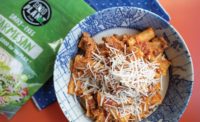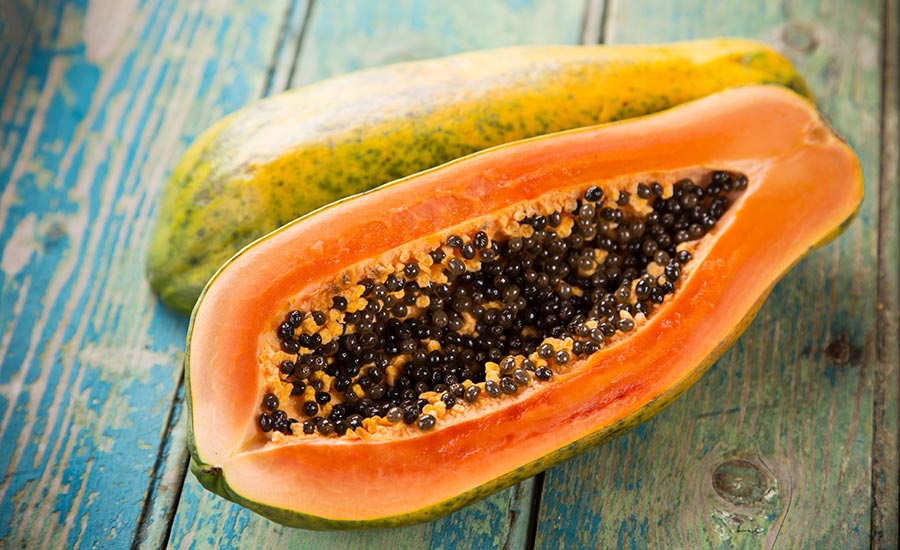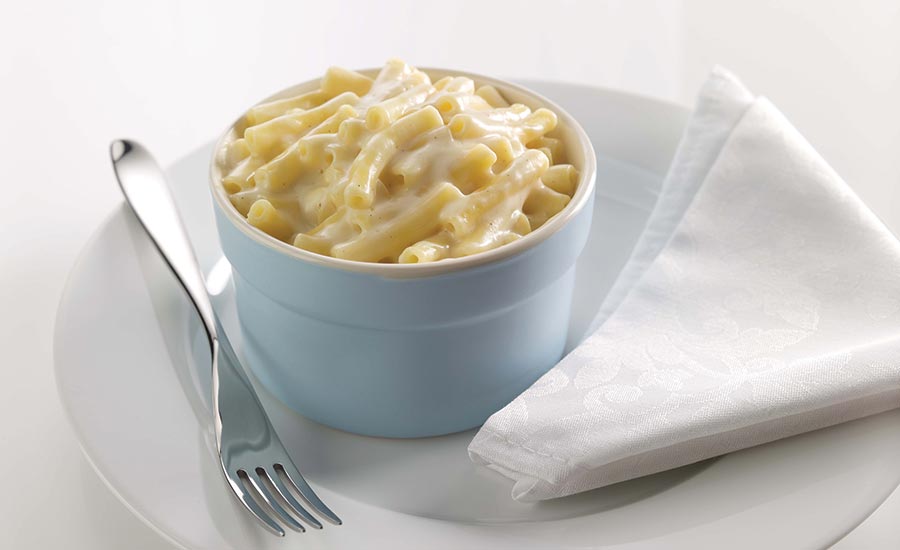Enzymes: Unsung Heroes
Enzymes are the silent workhorses of the ingredient world

PHOTO COURTESY OF: NOVOZYMES A/S (www.novozymes.com)

Enzymes sometimes go by their chemical names, but natural sources such as papaya (for papain) may be included on the label to avoid consumer confusion.
PHOTO COURTESY OF: iStock

A popular development in enzyme technology has been the replacement of animal-derived rennet for making cheeses, allowing for a vegetarian label.
PHOTO COURTESY OF: Biocatalysts Ltd. (www.biocatalysts.com)

Natural enzymes can be used to accelerate breakdown of meat proteins in order to enhance flavors and textures in gravies and sauces.
PHOTO COURTESY OF: Brenntag North America Inc. (www.brenntag.com)

Balanced blends of enzymes and other active ingredients can decrease stickiness in a dough yet maintain the softness needed for delicate pastries.
PHOTO COURTESY OF: CSM NV/Corbion America Inc. (www.corbion.com)

Enzymes are used commonly to improve bread quality and even to encourage germination for sprouted grains.
PHOTO COURTESY OF: iStock






Enzymes help solve some of the biggest challenges in the food processing industry. This makes them especially valuable for handling today’s “hot button” issues of sugar reduction, sustainability, and acrylamide reduction, as well as applying to a myriad of clean-label approaches. They often are unsung heroes used throughout food and beverage manufacturing.
Enzymes have been used in food production since before recorded history. They include the proteins that were unwittingly incorporated by our ancestors in making cheese and fermented dairy products, leavening bread, fermenting wine, and brewing beer.
Table of Contents
Today, enzyme use is experiencing a resurgence through new, advanced understandings of microbiology, discovery and creation of enzyme-producing microorganisms, genetic engineering technologies, and more comprehensive knowledge about how food systems work.
Naturally occurring enzymes in yeasts and bacteria have been used for centuries in the commercial production of bread, beer, wine, cheese, vinegar, sausage, cocoa, and many other foods that people enjoy.
Enzymes can help tenderize the toughest of meats and produce essential vitamins, nutrients, and flavor compounds. Sometimes, enzymes are even used as food safety tools that cause bacteria to literally explode.
By making enzymes more consistent, effective, affordable, and efficient, processors have been able to replace harsh chemicals and enhance the manufacture and quality of a variety of everyday products.
Competitive Advantage
Unique enzymes can offer considerable competitive advantage over their off-the-shelf cousins. Pectin methylesterase helps control the firmness of fragile fruits and vegetables like raspberries, strawberries, and tomatoes without itself being damaged and breaking down during the processing and production of jams, preserves, and yogurt.
In tortilla production, enzymes help meet a number of emerging market demands. Lipase and amylase step in to replace emulsifiers to reduce staling. Lipase softens and deters staling of the crumb by cleaving triglycerides into fatty acid chains that wrap around the amylose molecule fractions produced by the action of amylases.
The resultant starch complexes are monoglycerides formed endogenously in the process. They reduce starch crystallization and diminish the extent of staling. Amylase, lipase, and xylanase help replace hydrocolloids such as xanthan gum by enhancing dough flexibility, machinability, and the sensation of moistness, thereby prolonging tortilla shelflife.
Fluctuations in process time and temperature can, however, affect enzyme activity. Unlike traditionally conditioned doughs, enzyme-enriched doughs require precision with time and temperature. They can tend to become sticky or unmanageable in other ways.They may, however, be saved by carefully metering back enzymes in smaller amounts to reduce line waste.
Understanding the properties of an enzyme is important. Residual enzyme activity can be an issue as well, especially with heat-stable bacterial amylases. These are not completely inactivated in the oven as are fungal amylases, so they can result in products that stick together during storage. Packaged tortillas are an example of a product where such considerations are critical.
Another Side of Enzymes
Not all endogenous enzymes in food are beneficial. New processing methods are focusing on enzyme activity as a critical element of quality and safety. High isostatic pressure (HIP) and high-pressure homogenization (HPH) are non-thermal physical processing technologies.
Pressures up to 1200MPa and 400MPa, respectively, induce changes in the quaternary, tertiary and secondary stages of enzymes to affect the active site configuration. This level of control can cause desirable changes in food and other products.
Mild processing conditions help improve the activity and the stability of several enzymes, whereas extreme process conditions induce enzyme denaturation with consequent reduction of biological activity.
Manipulation of both processes is emerging as tool to deliberately change the performance of enzymes toward enhancing the quality and safety of foods.
HIP and HPH are emerging as commercial processes of choice for the stabilization of fruit and vegetable products by inactivation of degrading enzymes, without the deterioration of vitamins or flavor by heat. They have proven especially effective in fruit and vegetable purées and juices, including tomato, strawberry, apple, lychee, pear, coconut water and orange as well as purées of tubers.
Alyson Eberle, founder of Riley Pure LLC, makers of Pure Spoon fresh organic fruit and vegetable purées for babies and toddlers, relies on high-pressure processing (HPP) to inactivate the peroxidase and polyphenoloxidase enzymes that would otherwise impact the flavor, color, and texture of its pulps and purées. This helps preserve the freshly prepared taste of banana, pear, apple, and strawberry in its line of foods for babies.
The Sweet Low-down
Consumers want less sugar in their foods, without losing the flavor they enjoy. Balancing these conflicting demands is especially challenging to formulators of dairy products which tend to be sweetened when flavored. Lactase is a common, natural enzyme that converts lactose, which occurs naturally in milk, into glucose and galactose. Lactase is used throughout the dairy industry to make lactose-free products.
Galactose is almost four times as sweet as lactose. The dairy company fairlife LLC used this to its advantage in creating its lactose-free, rich and creamy reduced fat ultra-filtered fairlife brand chocolate milk. The product has half of the sugar of standard chocolate milk, without sacrificing its sweetness.
fairlife does not promote the reduced-sugar aspect of its product. The company took this daring (non-)marketing approach to avoid having consumers assume that less sugar would mean less flavor. Yet the absence of lactose is promoted to appeal to those consumers who are lactose sensitive and lactose intolerant.
Unilever N.V.’s Breyer’s Dairy uses lactase to convert the otherwise gritty textured lactose into a lactose-free light ice cream that has a sweet flavor and creamy texture. This is believed to be a result of the sugar being in the form of monosaccharides instead of disaccharides.
A recent innovation is lactase derived from Bifidobacterium bifidum bacteria, as opposed to the traditional yeast-derived lactase. Yeast-derived lactase is often contaminated with low levels of oligosaccharide- producing enzymes. The bacteria-derived lactase is a purer system that allows for a more rapid and precise reduction of lactose to the desired level of close to zero, leaving only the galactose and glucose monosaccharides and no oligosaccharides.
When combined with the appropriate culture system, a lactose-reduced fermented product—yogurt or drink—is not only sweeter but also develops buttery notes and acidic flavors for a rich, authentic fermented taste.
Acrylamide Action
Scientists discovered in 2002 that acrylamide, a suspected carcinogen, was formed by the Maillard reaction of the amino acid asparagine with reducing sugars during high-temperature cooking methods, such as grilling, baking, and frying. Unfortunately, these are the cooking methods that produce the flavors, aromas, and textures that consumers love. In 2010, the WHO/FAO Joint Expert Committee on Food Additives concluded that acrylamide may be “a human health concern.” The ensuing worldwide focus on reducing acrylamide is also ramping up demand for asparaginase, an enzyme that reduces acrylamide formation by converting asparagine to aspartate. In 2016, the FDA published a guidance suggesting ways to reduce acrylamide levels but without identifying any specific limits. “Baking and toasting …to a light brown, not a dark brown color; and avoiding overly dry or crusty products may help reduce acrylamide...,” according to the FDA’s nonbinding recommendations. These recommendations also include the suggested use of asparaginase to help reduce acrylamide in cereal-based foods and potato-based foods.
Protein Breakdown
Enzymes are hugely important in cheese-making. The milk-coagulating enzyme component of rennet and rennin, called chymosin, is traditionally isolated from a calf’s stomach lining. These forms of chymosin, however, are unsuitable for crafting vegetarian cheeses. Yet, chymosin derived from vegetables or microbes (fungi or bacteria) has proven ineffective for making cheddar and other hard cheeses.
Fermentation-produced chymosin is nature-identical to the calf chymosin used in the production of more than 90% of the cheese products found in the US market today. For competitive advantage, cheese companies do not spell out chymosin but include it in the catch-all term ‘enzymes’ on the label.
Many consumers actively seeking high-protein dairy foods encounter bland flavors and can even fall prey to digestive ills associated with certain added proteins. Enzymes called proteases help shorten the polypeptide sequences of lactalbumin and lactoglobulin. This will make proteins such as whey easier to digest and less likely to cause allergic reactions.
The dairy industry uses proteases to make creamier Greek yogurts with the addition of whey proteins. This has proven to be an acceptable approach compared to the traditional but time- and labor-intensive straining method.
Enzymes are key in the production of partially hydrolyzed whey infant formula for babies who have allergies or intolerances to cow’s milk proteins. One such product is Gerber Products Co.’s “Good Start Gentle Stage 1” infant formula which transparently labels its whey protein concentrate as “from milk, enzymatically hydrolyzed.”
Enzymes in Digestion
Enzymes can have a therapeutic role in nutrition. For example, prolyl-endopeptidase, from the Aspergillus niger fungus, shows promise in helping gluten-intolerant individuals. It breaks down gluten in the stomach to eradicate the proline-rich T-cell stimulatory epitopes from gluten proteins before they reach the small intestine.
Oxalates occur ubiquitously in foods. Consuming oxalate-rich foods regularly can exacerbate kidney stone symptoms and increase the propensity for developing additional stones. The low-oxalate diets prescribed for those afflicted with kidney stone and other urinary tract issues is difficult to adhere to because of the prevalence of oxalate in foods and the fact that they are not declared on Nutrition Facts labels.
Nature-identical versions of the oxalate decarboxylase enzyme are now sold directly to consumers to add to foods and beverages, during preparation or just before consumption of a meal that includes oxalates.
Enzyme combination could offer recovery benefits for athletes. Atrium Innovations Inc.’s Wobenzym is a preparation combining bromelain (from pineapple), papain (from papaya), porcine pancreatin, porcine trypsin, bovine chymotrypsin, and rutin from the Japanese pagoda tree
(Styphnolobium japonicum) to help reduce exercise-induced muscle damage and the associated delayed onset of muscle soreness. It is especially useful for athletes engaged in high-frequency training. The company was recently acquired by Nestlé SA for $2.3 billion.
These enzyme-based preparations are paving the way for a new category in the dietary supplement aisle, as well as new ways for manufacturers to enhance their product portfolio.
Processing Aids
The endogenous enzymes (“endo-enzymes”) that exist naturally in foods and can affect their quality. For example, pectin methyl esterase (PME), endogenous to fruits and vegetables, hydrolyzes pectin esters and changes the viscosity and clarity of juices and pulps. Endogenous enzymes can deteriorate the color, flavor, structure and nutritional value of fruits and vegetables.
In cold-break processing of tomato pulp, heating the product to 60°C (140°F) allows the PME to depoly-merize pectin to lower viscosity and facilitates separation of tomato solids from the clear liquid. In hot-break processing, which is conducted at 90°C (194°F), heat inactivates PME so that the pectin is preserved, and the finished tomato paste is cloudy and viscous.
Exogenous enzymes (“exo-enzymes”) are enzymes added deliberately to produce a desirable effect. For example, pectin esterase is used to break down pectin in fruit and vegetable pulps to form thin pastes, enhance juice concentrations, and to clarify wines. It increases the yield of fruit juice concentrates and also helps with gelation which modifies the texture of the juice and improves its quality tremendously.
Proteases break down the peptide linkages in proteins. Plant-based proteases such as papain (from papaya), bromelain (from pineapple), and ficin (from fig) are used in the production of clean-label marinades and synthetic preservative-free dry cured ham.
Cellulose, hemicellulose, pectin (all carbohydrates), and lignin are ligno-cellulosic substrates present naturally in large amounts in fruits and vegetables. These hinder juice and pulp processes and may be hydrolyzed by different lignocellulose-degrading enzymes for easier processing of juices and pulps with enhanced flavor, texture, and greater yield.
Good Condition
Consumer scrutiny of ingredient lists has pushed the “clean label trend” forward and one category has experienced rapid change to meet the demand: sandwich bread. Sliced bread is a staple food in most households, especially those with children. Bakers have been actively seeking clean-label methods to abbreviate and simplify these important products.
Conditioners, depending on their composition, offer a number of functionalities to bakers. Enzymes are a consumer-friendly alternative and there is an enzyme for practically every functionality. There is no single slam-dunk enzyme to deliver all of the effects of chemical conditioners in a single swoop because conditioners, depending on their composition, offer a wide range of functionalities in various bakery applications, and one has to consider every aspect for a perfect match.
Collaboration with suppliers can provide insights that lead to substantial savings.
Consumers wary of unfamiliar or “chemical sounding” ingredients have been avoiding breads that use traditional dough conditioners such as azodicarbonamide (ADA), diacetyl tartaric acid esters of mono- and diglycerides (DATEM), and sodium stearoyl lactylate (SSL). Used for decades, the efficacy of these ingredients in turn depend on their constituent emulsifiers, oxidizing agents, and reducing agents to improve dough machinability and tolerance. They also enhance finished product quality in terms of loaf volume, crumb structure, crumb softness and resilience.
Oxidative enzymes such as glucose oxidase, peroxidase, and lipoxygenase catalyze various substrates to create natural oxidation and increase di-sulfide bridges that strengthen and lighten the gluten matrix and dough. Campbell Soup Co.’s Pepperidge Farm brand uses oxidative enzymes to replace ADA in its Goldfish Baked Snack Crackers.
Enzymes such as hemicellulase, xylanase and pentosanase are used to modify various carbohydrates to make the dough extensible yet stable enough to produce greater oven spring and volume.
Another enzyme, transglutaminase helps build cross links between glutamine and lysine to strengthen the gluten matrix, and in turn toughen up a slack dough to provide improved volume and stability to breads.
In baked goods and other products cellulases are used to help digest cellulose fibrils into smaller, shorter units that absorb water and thereby improve machinability. In baking, they can help dry sticky whole-grain doughs. On the other hand, maltogenic enzymes can moisten a dough that’s too dry, and can render the dough more resilient through the harsh conditions of commercial processing.
Drop-in Replacement
The matching-to-replace exercise is not a straightforward off-the-shelf process. Substitution requires analyzing specific functionalities of the constituents in terms of rheology and biochemical transformations happening at each step of the process.
These must come together precisely in the finished product to replicate aspects of quality, specifically appearance, taste, and texture.
The replacement requires careful definition of processing parameters such temperature, proof and bake time, pH, moisture content, and the presence of other ingredients. Additionally, enzymes require time and do not work if the conditions are not ideal.
Mapping out the time, temperature, pH, and moisture characteristics is essential to optimizing the functionality of each enzyme. The once robust and can-work-under-any-conditions baking processes have to be tightened and managed closely for enzyme containing formulations.
It can be an unnecessary risk to try to find a replacement enzyme system on one’s own. Collaboration with suppliers can provide insights from other trials with substantial savings in time and effort to optimize functionality, dosage, and getting the right enzyme balance customized for your product and processing system.
Making It Last
All foods expire—some sooner than others—and the mode of failure depends on the type of food. There are three modes of failure for baked goods: moisture migration and staling; microbial growth; and oxidation of fat. These processes tend to happen more rapidly in gluten free products.
The use of enzymes is gaining ground in multiple aspects of food processing.
Staling or the drying out of the crumb happens because of starch recrystallization (also called retrogradation) in baked products. During baking, starch molecules absorb water, swell, and lose the crystalline structure that gives the crumb a crunchy texture. During storage, the soft and pliant starch molecules recrystallize or retrograde and become harder and appear to be dry.
Enzymes can help modify these processes to increase longevity and reduce spoilage and product waste. As a bonus, they can also work synergistically to keep products fresher tasting throughout the life cycle which may be just a few days in foodservice systems or more than a month in retail systems.
Amylases help products retain their original production freshness by modifying primarily the amylopectin portion of the wheat starch, which greatly reduces retrogradation over time, resulting in a softer product.
Enzymes that can help slow down staling effects and prolong softness include maltotetrahydrolases and other amylases. They modify the amylopectin chains of the wheat starch and deter recrystallization. Phospholipase enzymes and bacterial xylanases can provide additional softness in multigrain sweet baked goods such as cakes, muffins, doughnuts, and pastries to stay fresher, longer.
Gluten-free Help
Retaining moisture to slow down age-related deterioration is of particularly great concern for makers of gluten-free baked goods. These tend to dry out faster than their conventional counterparts. Additionally, each alternative flour hydrates and retrogrades differently, demanding unique solutions for each formulation.
Transglutaminase can modify protein functionality and promote cross-linking of proteins from different origins, including buckwheat, rice, potatoes, and legumes. The cross-linking can help deter recrystallization and the associated staling and hardening.
Alpha-amylase works just as well in gluten-free flatbreads such as tortillas and chapatis by enhancing dough extensibility properties, markedly improving the texture of the finished product. This will increase shelflife by reducing the rate of starch retrogradation.
Glucose oxidase is a less controversial enzyme alternative to chemical oxidizing agents in gluten-free baked goods. When used at 0.01-0.03% of flour weight, the enzyme lowers the concentration of thiol and amino groups, and improves cross-linking of proteins, thereby enhancing the firmness and elasticity of doughs made with rice and potatoes. It helps give the finished products improved volume and soft crumb.
Laccase is an enzyme produced by pure culture fermentation of a strain of the beneficial fungus Aspergillus oryzae. Commonly used in Japanese cuisine and also known as koji, it is typically used to ferment rice and soybeans. Thanks to its network-forming properties, laccase also has proven beneficial for retaining a soft, springy texture in gluten-free products.
Regulatory Issues
A major advantage of enzymes in foods is that they are largely categorized as processing aids rather than ingredients and are generally minimally functional in the final product. This does not, however, mean skipping the mention of enzymes in the ingredient list altogether.
If an enzyme is used in a formulation, it must be declared. However, formulators may use the source itself rather than the extracted enzyme to avoid using chemical-sounding names.
“Naturally occurring” does not always mean inherently safe. Although enzymes can be used to make food safer (as in the removal of acrylamide and mycotoxins), food safety principles for food processing inspired by nature should be addressed in hazard analysis and critical control point (HACCP) programs, as with any kind of food processing.
Specifically, enzymes should be checked for potential allergenicity and for their potential to generate side products, before and after eventual further processing. The FDA requires that food additives, including enzymes, have a generally recognized as safe (GRAS) status.
Enzymes are remarkable biocatalysts. Historically, processing strategies that focused on eliminating enzymes to preserve the quality of foods are exhibiting a paradigm shift toward processes taking advantage of enzymes as clean label alternatives for undesirable preservatives, stabilizers, and even flavor ingredients.
The use of enzymes is gaining ground in multiple aspects of food processing. Enzymes complement today’s clean label demand for simple declarations on ingredient statements, less offensive / harmful alternate resources, sustainable practices with favorable margins.
Originally appeared in the February, 2018 issue of Prepared Foods as Unsung Heroes.
Looking for a reprint of this article?
From high-res PDFs to custom plaques, order your copy today!












